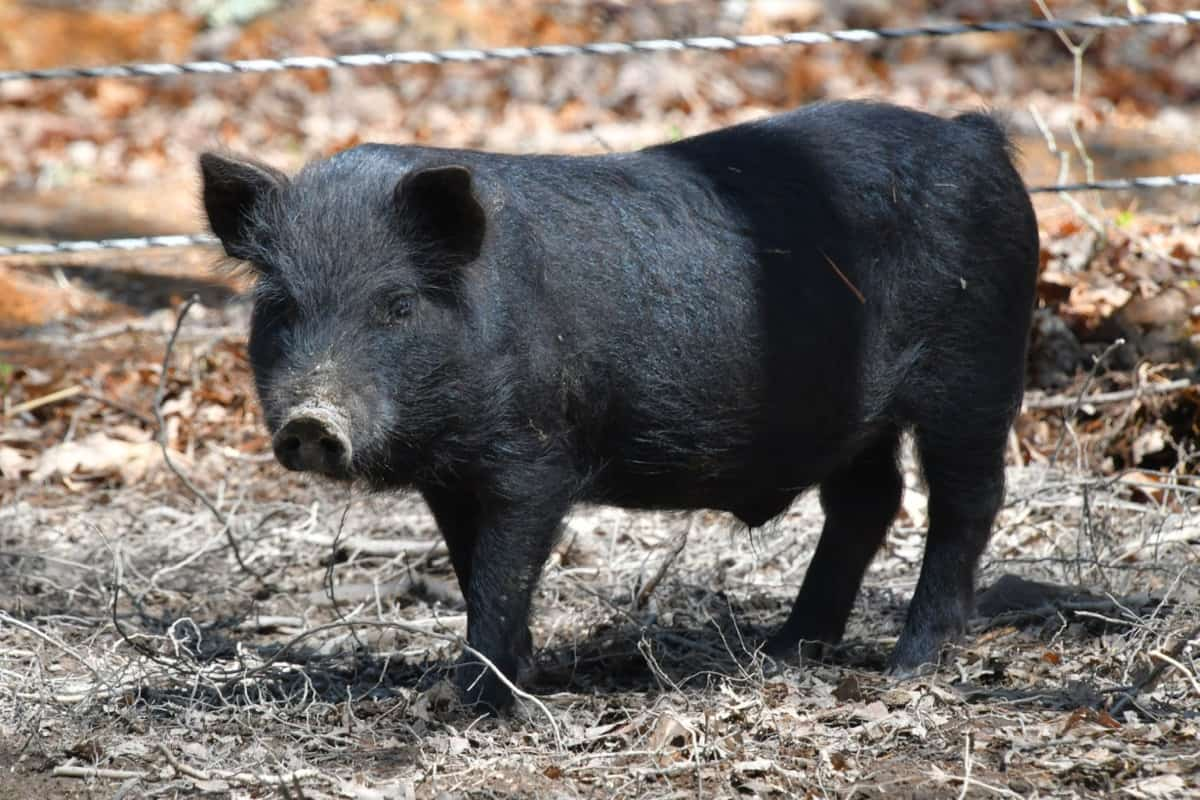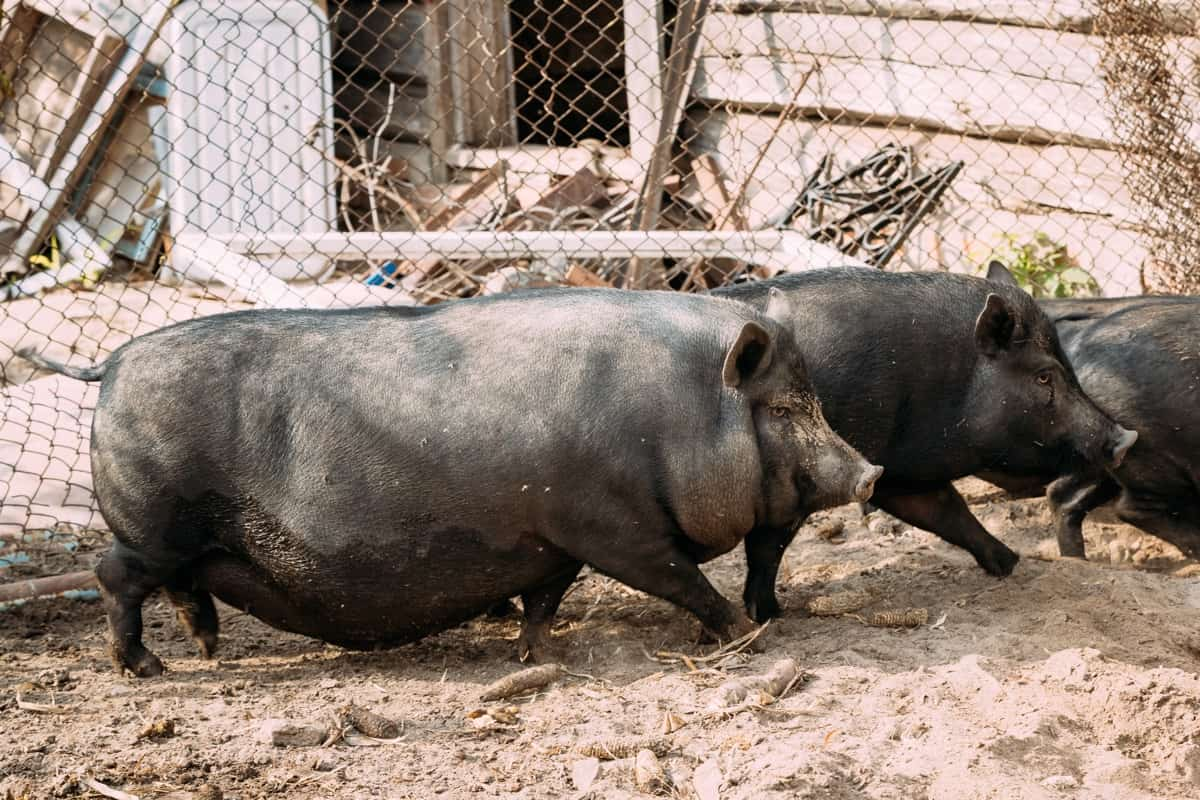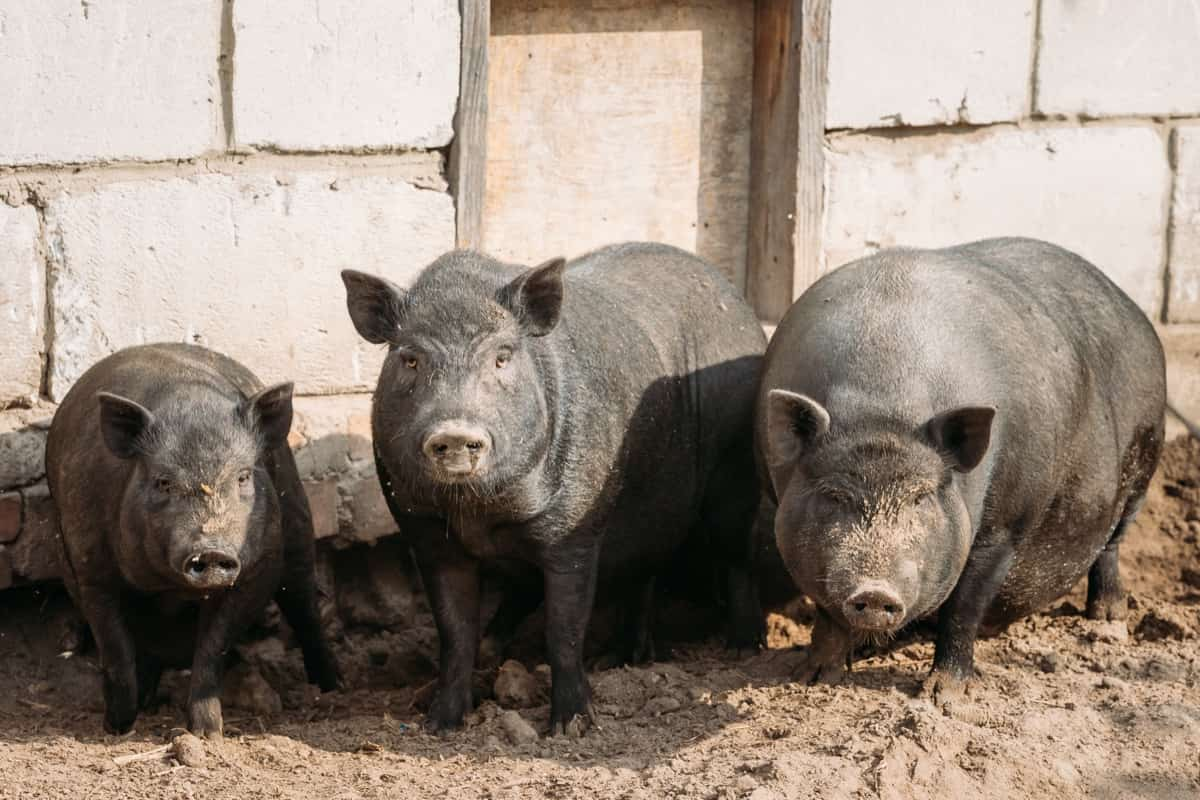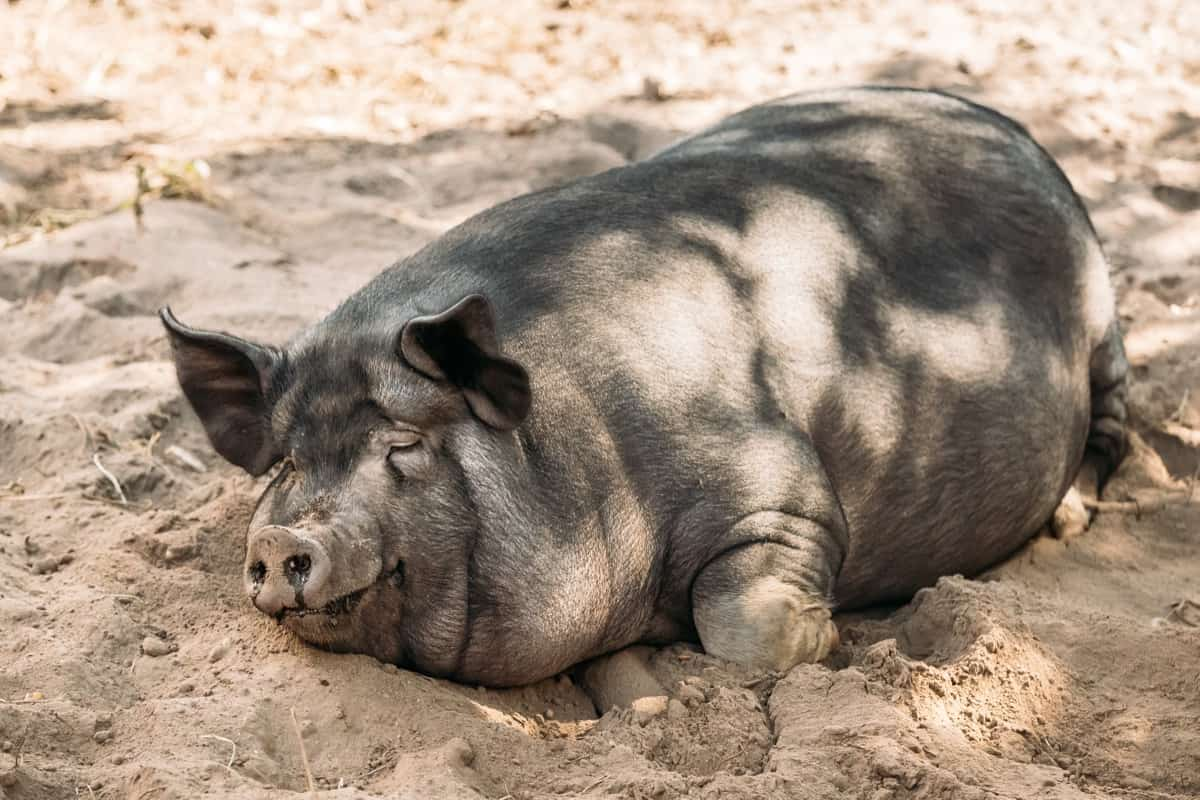Welcome to our blog, where we delve into the fascinating world of Large Black Pigs. This article will explore their origin, size, physical characteristics, and the pros and cons of raising them. Large Black Pigs are an intriguing breed with a rich history and unique traits. We will provide you with accurate and concise information, ensuring easy comprehension. We’ll cover everything from their origin facts to their distinct physical characteristics. Whether you’re a farmer or simply curious about these magnificent animals, join us on this journey of discovery.

Large Black Pig Facts
Introduction to Large Black Pigs
The Large Black pig, a British breed of domestic pig, stands out as the only completely black pig native to Britain. This unique breed was developed in the late 19th century by merging the black pig populations from Devon, Cornwall, Essex, Suffolk, and Kent. Known for its hardiness, docility, and high fertility, the Large Black pig is an excellent forager, making it suitable for extensive farming practices. However, it could be better suited to intensive management.
During the early 20th century, the breed enjoyed success and was exported to various parts of the world. Unfortunately, after the Second World War, the Howitt Report discouraged rearing all pig breeds except three suitable for intensive farming. This led to a decline in the population of Large Black pigs, with near-extinction occurring in the 1960s. Although numbers have since increased, the breed remains endangered, highlighting the importance of conservation efforts.
Large Black Pig Origin Facts
The Large Black pig, known by various names like Devon pig, Cornwall Black, and English Black, hails from Great Britain. This breed emerged through the combination of black pigs from Devon and Cornwall in the southwest of England and from Essex, Suffolk, and Kent in the east. The pigs from the eastern regions, particularly Essex, were influenced by Chinese imports in the late 18th century. On the other hand, the pigs from Devon and Cornwall were likely more closely related to mainland European breeds, particularly those from France.
Originally, the Devon pigs were selected for their body length, ears, noses, tails, and hair, with longer favored features, with little consideration for quality or substance. However, selective breeding gradually improved the breed, resulting in small-boned and thick-bodied pigs with good conformation and overall constitution by around 1850.
In case you missed it: Wessex Pig Facts: Origin, Size, Physical Characteristics, Pros, and Cons

History of Large Black Pigs
The history of Large Black pigs is rooted in the amalgamation of black pigs from distinct regions of England. The breed emerged from the combination of pigs from Devon and Cornwall in the southwest and Essex, Suffolk, and Kent in the east. During the late 19th century, the popularity of Large Black Pigs grew, leading to the formation of the Large Black Pig Society in Ipswich, Suffolk, in 1898 or 1899.
The breed association registered a trademark in 1902, featuring the letters LBP within a shield. The Herd Book of Large Black Pigs was published in 1899, combining the black pigs from Devon and Cornwall with remnants of smaller black breeds from Essex, Suffolk, and other East Anglian regions. In the 1920s, the breed peaked in popularity, with a Large Black sow being named Supreme Champion at Smithfield and a significant number of Large Blacks entering the Royal Show.
However, after World War II, the breed’s population declined as farmers favored pig breeds better suited for intensive indoor farming. In 1949, the breed association merged with the National Pig Breeders Association. The Howitt report, published in 1955, recommended focusing on three pig breeds for British farmers, leading to a decline in other traditional British pig breeds, including the Large Black.
The breed was listed as endangered when the Rare Breeds Survival Trust was established in 1973. Large Black pigs were exported to various countries, including Australia, North and South America, Africa, and Oceania. In Australia, they were chosen over Berkshire pigs for their ability to survive in hot weather, foraging skills, and high fertility.
However, the breed’s population remained relatively low, representing only 1 percent of the Australian pig population. The first exports of Large Blacks to the United States occurred in the 1920s, but the population dwindled, necessitating new imports in 1985. Presently, small herds descended from the imported pigs can be found in the US, as well as in Canada, Australia, and South Africa.
Size and Weight of Large Black Pigs
On average, large male Black pigs weigh around 350 kilograms (770 pounds), while large female Black pigs weigh approximately 300 kilograms (660 pounds). These figures provide a general guideline for the weight range of these pigs.
In case you missed it: Kolbroek Pig Facts: Origin, Size, Physical Characteristics, Pros, and Cons

Physical Characteristics of Large Black Pigs
- Size: Large Blacks are long and deep-bodied pigs well-suited for extensive farming.
- Foraging Ability: They excel in pasture-based farming due to their strong foraging and grazing skills, efficiently converting poor-quality feed into meat.
- Coloration: Large Blacks are the only all-black pig breed in Britain. This black pigmentation helps protect them from sunburn in sunny climates.
- Temperament: Large Blacks have a docile temperament and are easily contained by fencing. Their large, drooping ears partially obstruct their vision and protect the face and eyes while foraging.
- Fertility and Maternal Instincts: Sows exhibit long periods of fertility and strong maternal instincts. They typically give birth to large litters of 8-10 piglets, with some sows known to have had litters of up to 13 piglets. A Large Black sow holds the Guinness World Record for producing the largest litter ever recorded for a pig, with 26 litter between 1940 and 1952.
- Weight: Boars weigh around 700 to 800 pounds (320 to 360 kg), while sows weigh approximately 600 to 700 pounds (270 to 320 kg). However, it’s important to prevent obesity in sows, as it can lead to cystic ovaries and reduced fertility.
- Meat Production: Large Blacks were primarily used for meat production, particularly bacon. Their meat is known for its poor quality and flavor, without excessive back fat. In commercial production, they were often crossed with Yorkshire and Middle White pigs to create vigorous hybrids that farmers highly regarded.
Uses and Benefits of Raising Large Black Pigs
- Meat Production: Large Blacks are well known for their high-quality meat, particularly bacon, which is lean and flavorful.
- Extensive Farming: They are ideally suited for extensive farming systems, thriving in pasture-based environments.
- Foraging Ability: Large Blacks have strong foraging and grazing abilities, efficiently converting poor-quality feed into meat.
- Hardy and Docile: They possess a hardy nature and a docile temperament, making them easy to handle and contain.
- Maternal Instincts: Sows exhibit strong maternal instincts and have long periods of fertility, resulting in large litters of piglets.
- Endurance: Large Blacks are known for their endurance and adaptability to various climates and conditions.
- Genetic Conservation: By raising Large Black pigs, farmers contribute to conserving an endangered breed and help maintain genetic diversity in pig populations.
- Historical Significance: These pigs have a rich history and are important to British agricultural heritage.
In case you missed it: Tamworth Pig Facts: Origin, Size, Physical Characteristics, Pros, and Cons

Unique Facts About Large Black Pigs
- Exterior Characteristics: Large Black pigs have large trunk sizes, harmonious and proportional physique, and medium-sized, short heads.
- Distinctive Ears: They have neatly placed, long ears that fall over the eye area, protecting while foraging.
- Broad Chest: The chest is broad and often compared to the shape of a barrel, creating a convex appearance.
- Endurance and Adaptability: Large Blacks are known for their endurance and ability to adapt to different climates and conditions.
- Weight and Meat Composition: Adult males weigh around 250-400 kg, while mature females weigh about 200-300 kg. Their carcasses contain approximately 51-52.5% meat and 40-41.5% fat.
- High Fertility: Sows give birth to large litters of 10-12 piglets on average, with the piglets weighing 55-70 kg.
- Crossbreeding Benefits: Crossbreeding with Large Blacks, particularly with Large White pigs, has shown improved results, such as higher survival rates and increased daily weight gain in piglets.
- Skin Wrinkles and Loose Back: A notable characteristic of Large Black pigs is the presence of wrinkles on the skin and lose backs, although these are considered minor disadvantages.
Cons of Large Black Pigs
- Prone to Obesity: Large Blacks tend to become overweight, requiring careful diet monitoring.
- Skin Issues: The breed is susceptible to skin problems, including wrinkles and looseness.
- Limited Commercial Demand: Commercial processors often do not favor the black skin of purebred Large Black pigs, limiting their market demand.
Conservation Status of Large Black Pigs
The breed is considered rare in the UK, with a small population. In 1954, 2,195 recorded Large Blacks were recorded, representing approximately 3.4% of the UK pig population. By the end of 2011, the registered population increased to 421 (86 boars and 335 sows). The breed is classified as “vulnerable” on the watchlist of the Rare Breeds Survival Trust, with an estimated 200 to 300 breeding females.
In the United States, the American Livestock Breeds Conservancy estimated a population of 300 breeding hogs in 2008. The breed’s status is classified as “critical,” with fewer than 200 animals registered annually and fewer than 2,000 worldwide. Large Blacks are gaining attention as a good choice for pasture-raised pork, meeting the needs of consumers interested in sustainable agriculture.
In case you missed it: Auckland Island Pig Facts: Origin, Size, Physical Characteristics, Pros, and Cons

In Australia, the Rare Breeds Trust listed the Large Black as “critical” in 2004, indicating that sow registrations were fewer than 30 per year. Only one remaining herd of Large Blacks was identified in Canada in 1997. The breed is listed as “endangered” on the conservation watchlist of Rare Breeds Canada, with fewer than 500 animals in the country.
Large Black Pigs Breed Traits and Temperament
Breed Traits
- Large and deep-bodied with a harmonious and proportional physique.
- Long head with neatly placed ears that fall over the eye area.
- Broad chest and a dorsal part that is broad, straight, and slightly elongated.
- Well-developed, rounded debarking part contrasting harmoniously with the hock.
- Strong and straight legs with robust hooves.
- Black coloration protects them from sunburn in sunny climates.
Temperament
- Docile and easily contained by fencing.
- Their large, drooping ears may obscure their vision but protect them while foraging.
- Well known for their strong maternal instincts and long periods of fertility.
- Sows give birth to a large litter, ranging from 8 to 13 piglets.
- They are generally gentle and easy to handle, making them suitable for extensive farming.
Large Black Pigs Growth Rate and Maturity
Large Black pigs have a moderate growth rate, which is slower in the early stages of their lives but becomes more consistent and steady as they mature. They can achieve satisfactory weight gain over time with proper nutrition and care. These pigs typically reach sexual maturity at around 8 to 9 months of age, enabling boars to be used for breeding and sows to conceive and give birth to litters.
Large Black Pigs Breeding and Reproduction
Breeding
Selecting healthy and genetically diverse breeding stock is crucial when breeding Large Black pigs. Boars and sows should be chosen based on conformation, temperament, and overall health. Introducing new bloodlines periodically helps maintain genetic diversity within the breed. Breeding should ideally occur when the sow reaches sexual maturity, usually around 8 to 9 months. It’s recommended to have a proper mating ratio of one boar for every ten to fifteen sows to ensure successful breeding.
Reproduction
Sows of the Large Black breed have a reputation for their strong maternal instincts. They typically have a large litter, ranging from 8 to 10 piglets, with some sows producing up to 13 piglets. The gestation period for Large Black pigs is around 114 days, or approximately three months, three weeks, and three days. During pregnancy, sows require proper nutrition and care to support their health and the development of the piglets. The farrowing process, where the sow gives birth, should occur in a clean and comfortable environment.
In case you missed it: Pietrain Pig Facts: Origin, Size, Physical Characteristics, Pros, and Cons

Conclusion
Large Black pig is a British heritage breed known for its origins in Devonshire. It has a large size, all-black coloration, and distinctive physical characteristics. It offers advantages such as hardiness and meat quality but can be prone to obesity.
- Goat Farming Technology: The Future of Goat Husbandry
- How to Build a Low-budget Goat Shed: Cheap Ideas and Tips
- Goat Farming Training Programs in India: A Beginner’s Guide
- Types of Pesticides Used in Agriculture: A Beginner’s Guide
- Economical Aquaculture: A Guide to Low-Budget Fish Farming
- 15 Common Planting Errors That Can Doom Your Fruit Trees
- How to Make Houseplants Bushy: Effective Tips and Ideas
- Innovative Strategies for Boosting Coconut Pollination and Yield
- Pollination Strategies for Maximum Pumpkin Yield
- The Complete Guide to Chicken Fattening: Strategies for Maximum Growth
- Natural Solutions for Tulip Problems: 100% Effective Remedies for Leaf and Bulb-Related Issues
- Revolutionizing Citrus Preservation: Towards a Healthier, Greener Future
- Natural Solutions for Peony Leaf and Flower Problems: 100% Effective Remedies
- Maximizing Profits with Avocado Contract Farming in India: A Comprehensive Guide
- Natural Solutions for Hydrangea Problems: 100% Effective Remedies for Leaf and Flowers
- The Ultimate Guide to Choosing the Perfect Foliage Friend: Bringing Life Indoors
- From Sunlight to Sustainability: 15 Ways to Use Solar Technology in Agriculture
- The Ultimate Guide to Dong Tao Chicken: Exploring from History to Raising
- The Eco-Friendly Makeover: How to Convert Your Unused Swimming Pool into a Fish Pond
- Mastering the Art of Delaware Chicken Farming: Essentials for Healthy Backyard Flocks
- 20 Best Homemade Fertilizers for Money Plant: DIY Recipes and Application Methods
- How to Craft a Comprehensive Free-Range Chicken Farming Business Plan
- Brighten Your Flock: Raising Easter Egger Chickens for Beauty and Bounty
- How to Optimize Your Poultry Egg Farm Business Plan with These Strategies
- Subsidy for Spirulina Cultivation: How Indian Government Schemes Encouraging Spirulina Farmers
- Ultimate Guide to Raising Dominique Chickens: Breeding, Feeding, Egg-Production, and Care
- Mastering the Art of Raising Jersey Giant Chickens: Care, Feeding, and More
- Ultimate Guide to Raising Legbar Chickens: Breeding, Farming Practices, Diet, Egg-Production
- How to Raise Welsummer Chickens: A Comprehensive Guide for Beginners
- How to Protect Indoor Plants in Winter: A Comprehensive Guide
- Ultimate Guide to Grow Bag Gardening: Tips, Tricks, and Planting Ideas for Urban Gardeners
- Guide to Lotus Cultivation: How to Propagate, Plant, Grow, Care, Cost, and Profit
- Agriculture Drone Subsidy Scheme: Government Kisan Subsidy, License, and How to Apply Online
- Ultimate Guide to Raising Araucana Chickens: Breed Profile, Farming Economics, Diet, and Care
- Bringing Hydroponics to Classroom: Importance, Benefits of Learning for School Students
- Ultimate Guide to Raising Polish Chickens: Breed Profile, Farming Economics, Diet, and Care